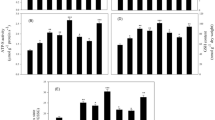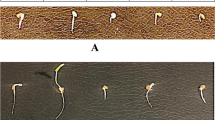Abstract
Nitric oxide (NO) is a bioactive molecule that is extensively used at various biotic and abiotic stresses. This study investigated the law governing the variation of related enzymatic activity and metabolites in exogenous NO-mediated GSH-PC synthesis pathway in tomato solution culture subjected to copper stress. Results demonstrated that relative to control copper stress was more effective in the activation of γ-ECS and GS in tomato. Moreover, sharp increases in root GSH and PCs were observed, which keep upward as the process continued. Moreover, adding exogenous SNP (NO donor) can further improve γ-ECS and GS activities in tomato roots and facilitate the synthesis of GSH and PCs, thereby enhancing its peroxide removal ability, chelating excessive Cu2+, and reducing its biotoxicity. The GSH-PC metabolism in the tomato leaves lagged behind that in the roots to a certain extent. Although exogenous GSH synthesis inhibitor BSO inhibited γ-ECS activity in tomato roots, as well as GSH and PC syntheses, adding SNP can counteract this effect by lessening the influence to the PCs in leaves. Under copper stress, exogenous NO may stimulate a signaling mechanism and reduce the biotoxicity and oxidative damage caused by excessive Cu2+ through activating or enhancing the enzymatic and non-enzymatic systems in the GSH-PC synthesis pathway.
Similar content being viewed by others
Abbreviations
- ASA:
-
Ascorbic acid
- BSO:
-
L-buthionine-(S,R)-sulfoximine
- DTNB:
-
5,5-dithio-bis(2-nitrobenzoic acid)
- DTPA:
-
diethylenetriaminepentaacetic acid
- GS:
-
glutathione synthetase
- GSH:
-
reduced glutathione
- GSSG:
-
oxidized glutathione
- Hb:
-
bovine hemoglobin
- H2O2:
-
hydrogen peroxide
- NEM:
-
N-ethyl-maleimide
- OPT:
-
o-phthalaldehyde
- PCs:
-
phytochelatins
- ROS:
-
reactive oxygen species
- SNP:
-
sodium nitroprusside dihydrate
- TAST:
-
total acid-soluble thiols
- TG:
-
total glutathione [GSH + GSSG]
- γ-ECs:
-
γ-glutamylcysteine synthetase
References
Cobbett, C. and Goldsbrough, P., Phytochelatins and metallothioneins: roles in heavy metal detoxification and homeostasis, Annu. Rev. Plant Biol., 2002, vol. 53, pp. 159–182.
Wejas, S., Ruszczyriska, A., Bulska, E., Clements, S., and Antosiewisz, D.M., The role of subcellular distribution of cadmium and phytochelatins in the generation of distinct phenotypes of AtPCS1-and CePCS3-expressing tobacco, J. Plant Physiol., 2010, vol. 167, pp. 981–988.
Kuzminov, F.I., Brown, C.M., Fadeev, V.V., and Gorbunov, M.Y., Effects of metal toxicity on photosyn-thetic processes in coral symbionts, Symbiodinium spp., J. Exp. Mar. Biol. Ecol., 2013, vol. 446, pp. 216–227.
Bona, E., Marsano, F., Cavaletto, M., and Berta, G., Proteomic characterization of copper stress response in Cannabis sativa roots, J. Proteomics, 2007, vol. 7, pp. 1121–1130.
Zhao, H., Wu, L., Chai, T., Zhang, Y., Tian, J., and Ma, S., The effects of copper, manganese and zinc on plant growth and elemental accumulation in the manganese-hyperaccumulator Phytolacca americana, J. Plant Physiol., 2012, vol. 169, pp. 1243–1252.
Boldizsár, Á., Simon-Sarkadi, L., Szirtés, K., Soltesz, A., Szalai, G., Keyster, M., Ludid, N., Galiba, G., and Kocsy, G., Nitric oxide affects saltinduced changes in free amino acid levels in maize, J. Plant Physiol., 2013, vol. 170, pp. 1020–1027.
Saxena, I. and Shekhawat, G.S., Nitric oxide (NO) in alleviation of heavy metal induced phytotoxicity and its role in protein nitration, Nitric Oxide, 2013, vol. 32, pp. 13–20.
Mhadhbi, H., Fotopoulos, V., Mylona, P.V., Jebara, M., Elarbi, Aouani, M., and Polidoros, A.N., Antioxidant gene-enzyme responses in Medicago truncatula genotypes with different degree of sensitivity to salinity, Acta Physiol. Plant., 2011, vol. 141, pp. 201–214.
Gill, S.S., Hasanuzzaman, M., Nahar, K., Macovei, A., and Tuteja, N., Importance of nitric oxide in cadmium stress tolerance in crop plants, Plant Physiol. Biochim., 2013, vol. 63, pp. 254–261.
Zhang, Y.K., Han, X.J., Chen, X.L., and Jin, H., Exogenous nitric oxide on antioxidative system and ATPase activities from tomato seedlings under copper stress, Sci. Hortic., 2009, vol. 123, pp. 217–223.
Dong, Y.X., Wang, X.F., and Cui, X.M., Exogenous nitric oxide involved in subcellular distribution and chemical forms of Cu2+ under copper stress in tomato seedlings, J. Integr. Agr., 2013, pp. 1783–1790.
De Vos, C.H.R., Vonk, M.J., Vooijs, R., and Schat, H., Glutathione depletion due to copper-induced phytochelatin synthesis causes oxidative stress in Silene cucubalus, Plant Physiol., 1992, vol. 98, pp. 853–858.
Ellman, G.L., Tissue sulfhydryl groups, Arch. Biochem. Biophys., 1959, vol. 82, pp. 70–77.
Hao, J.J., Kang, Z.L., and Yu, Y., Plant Physiology Experiment Technology, Beijing: Chemical Industry Press, 2006.
Lu, R.K., Agricultural Chemical Analysis Method of Soil, Beijing: China Agricultural Science and Technology Press, 2000.
Bradford, M.M., A rapid and sensitive method for the quantitation of microgram quantities of protein utilizing the principle of protein–dye binding, Anal. Biochem., 1976, vol. 72, pp. 248–254.
Tewari, R.K., Hahn, E.J., and Paek, K.Y., Modulation of copper toxicity-induced oxidative damage by nitric oxide supply in the adventitious roots of Panax ginseng, Plant Cell Rep., 2008, vol. 27, pp. 171–181.
Bai, X.G., Chen, J.H., Kong, X.X., Todd, C.D., Yang, Y.P., Hu, X.Y., and Li, D.Z., Carbon monoxide enhances the chilling tolerance of recalcitrant Baccaurea ramiflora seeds via nitric oxide-mediated glutathione homeostasis, Free Radic. Biol. Med., 2012, vol. 53, pp. 710–720.
Li, X.Y., Wang, X.F., Lu, L.F., Yin, B., Zhang, M., and Cui, X.M., Effects of exogenous nitric oxide on ascorbate–glutathione cycle in tomato seedlings roots under copper stress, Chinese J. Appl. Ecol., 2013, vol. 24, pp. 1023–1030.
Durzan, D.J. and Pedroso, M.C., Nitric oxide and reactive nitrogen oxide species in plants, Biotechnol. Genet. Eng. Rev., 2002, vol. 19, pp. 293–338.
El-Shabrawi, H., Kumar, B., Kaul, T., Reddy, M.K., Singla-Pareek, S.L., and Sopory, S.K., Redox homeostasis, antioxidant defense, and methylglyoxal detoxification as markers for salt tolerance in Pokkali rice, Protoplasma, 2010, vol. 245, pp. 85–96.
Mellado, M., Contreras, R.A., González, A., Dennett, G., and Moenne, A., Copper-induced synthesis of ascorbate, glutathione and phytochelatins in the marine alga Ulva compressa (Chlorophyta), Plant Physiol. Biochem., 2012, vol. 51, pp. 102–108.
Chen, J.J., Zhou, J.M., and Goldsbrough, P.B., Characterization of phytochelatin synthase from tomato, Acta Physiol. Plant., 1997, vol. 101, pp. 165–172.
Anjum, N.A., Ahmad, I., Mohmood, I., Pacheco, M., Duarte, A.C., Pereira, E., Umar, S., Ahmad, A., Khan, N.A., Iqbal, M., and Prasad, M.N.V., Modulation of glutathione and its related enzymes in plants’ responses to toxic metals and metalloids — a review, Environ. Exp. Bot., 2012, vol. 75, pp. 307–324.
Alosi, M.C., Melroy, D.L., and Park, R.B., The regulation of gelation of phloem exudate from Cucurbita fruit by dilution, glutathione, and glutathione reductase, Plant Physiol., 1988, vol. 86, pp. 1089–1094.
Seth, C.S., A review on mechanisms of plant tolerance and role of transgenic plants in environmental cleanup, Bot. Rev., 2012, vol. 78, pp. 32–62.
Chien, H.F., Lin, C.C., Wang, J.W., Chen, C.T., and Kao, C.H., Changes in ammonium ion content and glutamine synthetase activity in rice leaves caused by excess cadmium are a consequence of oxidative damage, J. Plant Growth Regul., 2002, vol. 36, pp. 41–47.
Ali, H., Khan, E., and Sajad, M.A., Phytoremediation of heavy metals–concepts and applications, Chemosphere, 2013, vol. 91, pp. 869–881.
Innocenti, G., Pucciariello, C., Le Gleuher, M., Hopkins, J., de Stefano, M., Delledonne, M., Puppo, A., Baudouin, E., and Frendo, P., Glutathione synthesis is regulated by nitric oxide in Medicago truncatula roots, Planta, 2007, vol. 225, pp. 1597–1602.
Noctor, G., Mhamdi, A., Chaouch, S., Han, Y., Neukermans, J., Marquez-Garcia, B., Queval, G., and Foyer, C.H., Glutathione in plants: an integrated overview, Plant Cell Environ., 2012, vol. 35, pp. 454–484.
Xiong, J., Fu, G.F., Tao, L.X., and Zhu, C., Roles of nitric oxide in alleviating heavy metal toxicity in plants, Arch. Biochem. Biophys., 2010, vol. 497, pp. 13–20.
Author information
Authors and Affiliations
Corresponding author
Rights and permissions
About this article
Cite this article
Wang, J., Yu, S.X., Zhang, M. et al. Exogenous nitric oxide-mediated GSH-PC synthesis pathway in tomato under copper stress. Russ J Plant Physiol 62, 349–359 (2015). https://doi.org/10.1134/S1021443715030188
Received:
Published:
Issue Date:
DOI: https://doi.org/10.1134/S1021443715030188




